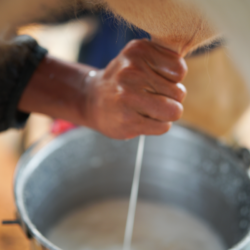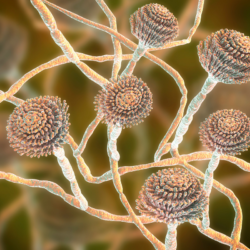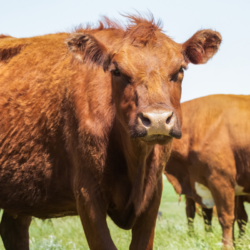Contagious Ecthyma, also known as ORF, is a viral skin infection. It mainly affects sheep and goats, but can also be transmitted to humans. This disease, caused by the ORF virus belonging to the Poxviridae family, manifests itself through characteristic skin lesions. It can lead to complications in immunocompromised individuals. Understanding the symptoms, diagnostic methods and treatment options for contagious Ecthyma is essential for effective management of this condition and prevention of its spread.
What virus causes contagious ecthyma?
Contagious Ecthyma, also known as Orf, is a zoonosis caused by the Orf virus of the Poxviridae family, of the Parapoxvirus genus. This virus is transmitted to humans through contact with infected animals. It is extremely resistant in the environment, persisting in contaminated soil, bedding and equipment. Infected animals can remain chronic carriers of the virus, contributing to its spread.
The disease manifests itself as skin lesions on animals. It is encouraged by contact with thistles, hay, untended pasture and stubble. Fattening workshops and the use of feed pellets can also increase the risk of infection. They can cause lesions around the mouth, making the animals more vulnerable.
The contagious Ecthyma virus mainly affects small ruminants, particularly goats. It can also affect other animal species as well as humans. It is present in the crusts and vesicular fluids of skin lesions. Although rare outside these lesions, it can persist in the environment for years.
The Ecthyma virus, belonging to the Poxviridae family and the Parapoxvirus genus, is an enveloped virus with double-stranded DNA measuring 160-190 nm in diameter and 250-300 nm in length. It replicates in the cytoplasm of infected cells. It is sensitive to certain chemical agents such as hydrochloric acid, phenol, iodine and bleach. However, it is highly resistant to heat and UV radiation.
This disease presents different strains of virus, varying in virulence and provoking different immune responses. The virus replicates in the upper layers of the skin and in the oral and oesophageal mucosa. It lasts in the environment, preserved by cold, but can be altered by dry heat.
How does it affect animals?
Contamination by the Orf virus occurs mainly by penetration of the virus through tiny wounds that are imperceptible to the naked eye. The first lesions generally appear on areas of hairless skin such as the lips, udders and feet. The incubation period varies from three days to one week.
Certain factors appear to favour infection, notably animal stress and high animal density. These conditions contribute to the spread of the disease and can increase the risk of transmission of the virus.
Symptoms
The clinical manifestations of contagious Ecthyma include crusty lesions on the skin and ulcerations of the mucous membranes . These are found particularly on the mouth, nostrils, eyelids and udders. In severe cases, lesions of the tongue and gums can lead to death from malnutrition in young animals. Symptoms can vary from one individual to another. Hairless areas, such as around the face and feet, provide a favourable environment for the disease to develop.
Severely affected lambs may have difficulty feeding for several days. This can lead to a deterioration in their health and increased susceptibility to other diseases, or even death from starvation. Although contagious Ecthyma is not fatal in itself, it has a significant impact on animal growth rates. In ewes, udder lesions can predispose to mastitis. This makes suckling painful and is often avoided by the lamb.
Lesions begin with the appearance of vesicles, which develop into fluid-filled pustules and then thick crusts. These crusts, along with the pus and vesicular fluid, are rich in virus. This encourages lesions to proliferate.
In kids, lesions take the form of warts or small fungi, mainly on the lips. They are often transmitted via teats or direct muzzle-to-muzzle contact. In adults, lesions take the form of crusts or oozing lesions. They are located in the interdigital spaces, the teats in females and the scrotum in males.
Atypical forms, such as the papillomatous form or severe forms combining local lesions with pneumonia or gastroenteritis, can also occur, but are rare.
Diagnosis
Clinical diagnosis is based on observation of the skin lesions (scabs, ulcers and pustules) and their location. As the disease is highly contagious, it is often easily identifiable.
Laboratory diagnosis involves electron microscopic examination of the dry scabs. Samples can be sent in a dry jar or in 10% formalin for analysis at ANSES Maisons Alfort or Sofia Antipolis.
The differential diagnosis must be made with several other diseases. These include foot-and-mouth disease, ulcerative dermatitis, sheep pox, necrobacillosis and bluetongue. These diseases have similar symptoms but different aetiologies.
To confirm the diagnosis, samples are taken from the lesions by scraping. Examination of the crusts under an electron microscope detects the presence of the virus. The characteristic morphology of the virus allows precise identification. Although contagious Ecthyma is generally identifiable, the lesions may be modified by superinfection, making diagnosis more difficult.
If ecthyma is suspected, particularly when papulo-pustular lesions appear on the lips of kids during the calving period, autopsies can reveal ulcerative lesions throughout the digestive tract.
Suitable samples include crusts, necrotic substances present on ulcers and biopsies of lesions taken from live animals or at necropsy. These samples can be stored for several days at 4°C without deterioration.
The virus can be detected by direct electron microscopy or by pathological examination. Transmission electron microscopy of samples detects the presence of the virus.
Treatment and management
In the event of superinfection, systemic antibiotic treatment is recommended. As there is no specific treatment, local care can speed up healing, such as the application of :
- Iodised glycerine
- Healing spray
- Clay
- Plant-based disinfectant and healing product for ecthyma lesions.
In the case of heavily affected livestock, vaccination is particularly useful in promoting rapid recovery. This treatment consists of two injections at an interval of 10 to 12 days, at a dose of 1 ml subcutaneously or 0.2 ml intradermally (not a marketing authorisation). The vaccine available in France is a live vaccine. However, its effectiveness remains limited due to the presence of several viral strains. This means that the vaccine’s immune response is incomplete.
Mothers are vaccinated 3 to 4 weeks before lambing. Lambs born to unvaccinated mothers are vaccinated at 15 days of age, with a dose of 1 ml subcutaneously or 0.2 ml intradermally using an automatic syringe. No treatment eliminates the virus, and the disease generally progresses over three to four weeks.
The spread of the disease can be slowed by moving affected herds to pastures with a lower risk of skin lesions, for example by avoiding areas with thistles or burdock. In severe cases, treatment to combat secondary infections may be necessary.
Sheep that recover from contagious ecthyma develop lifelong immunity to severe infections. However, they remain at risk of re-infection. Although rare, treatment is rarely beneficial. Therefore, pasture management and vaccination are the best methods of controlling the disease.
How is the disease transmitted?
The contagious ecthyma virus is transmitted in animals mainly by direct contact of injured skin or mucous membranes with contaminated sources, such as :
- Animals that are already infected
- Contaminated equipment used for tattooing, ear tagging, shearing, etc.
- Stony ground or injurious plants that can cause wounds, including in the mouth.
The scabs resulting from the disease can contaminate the environment for a long time.
In humans, transmission occurs mainly through contact between injured skin and infected animals or contaminated objects. The people most exposed to the risk of infection are livestock farmers, vets and all those working in the meat industry. Epidemics often peak during religious festivals, when sheep are traditionally sacrificed.
There is a vaccine available for animals to prevent the disease, which should be renewed every 6 to 8 months. In humans, the disease, known as Orf’s disease, is immunising, although reinfections can occur with less severe lesions.
Contamination can occur in both directions, with humans becoming infected by caring for affected animals, and animals becoming infected by sick people. The incubation period in humans is three to seven days. More severe cases are possible in immunocompromised individuals.
As far as the consumption of animal products is concerned, the carcasses of affected animals are generally edible, with the exception of the parts affected by lesions. Milk presents a risk of contamination if the teats are affected by virus-rich crusts. The usual milk processing methods are not sufficient to eliminate the viruses. It therefore represents a potential risk for consumers. However, transmission of the disease by this route appears to be rare in humans.
What are the symptoms in humans?
Symptoms of contagious ecthyma initially appear as a skin lesion that progresses through several stages. At the point of inoculation, a papule appears, evolving into a vesicle and then a pustule, sometimes accompanied by a lymph node. The incubation period lasts around a week.
The initial papule varies in colour (whitish, reddish, bluish), has a firm consistency and is tender but painless. It is usually located on the fingers, hands or forearms, and sometimes on the face or neck. The papule gradually enlarges to form a tumour nodule, sometimes covered by a pustule and then a central crust. An erythematous area surrounds the papule.
These nodules may be single or multiple, especially in the case of bites by an infected animal. General signs are rare, often associated with superinfection, and may include lymphangitis, satellite lymphadenopathy and sometimes fever.
Spontaneous healing generally occurs within 3 to 6 weeks, without scarring in the absence of local superinfection. Severe forms, although rare, can occur in individuals with impaired immunity. The infection manifests itself as a malignant tumour or significant superinfection. Erythema multiforme may develop within the first 8-10 days of infection. Cases of secondary erythema nodosum have also been reported.
The patient may develop regional adenopathy, lymphangitis and fever throughout the course of the disease.
What is the treatment?
When contagious ecthyma is suspected, the diagnosis is usually made on the basis of the patient’s history of exposure to infected animals or potentially contaminated environments. However, confirmation of the diagnosis often requires the exclusion of other skin conditions with similar symptoms.
The acute lesions of contagious ecthyma must be distinguished from milker’s nodules. The latter are benign lesions common in people exposed to agricultural work. In addition, infections caused by Mycobacterium marinum, a bacterium found in freshwater and marine environments, can also present similar symptoms.
As for the regressive lesions of contagious ecthyma, they may be confused with skin tumours such as Bowen’s disease (squamous cell carcinoma in situ) or squamous cell carcinoma (invasive squamous cell carcinoma). These different possibilities for differential diagnosis underline the importance of careful clinical assessment to correctly identify contagious ecthyma.
As far as treatment is concerned,contagious ecthyma is viral in origin and there are no specific drugs to eliminate the virus. Treatment options are therefore limited to managing symptoms and preventing complications. Bacterial superinfections can be avoided by using local antiseptics to clean the skin lesions. In most cases,contagious ecthyma lesions heal spontaneously without medical intervention, and generally do not leave scars, except in cases of severe superinfection.
However, in immunocompromised patients, such as those with HIV or receiving immunosuppressive therapy, the course of contagious ecthyma can be more severe and difficult to manage. In these cases, topical use of the antiviral drug cidofovir may be considered to help control the skin infection.
How can this disease be prevented?
General prevention measures aim to reduce the risk of Orf spreading on farms and to protect staff working with animals. They include general farm hygiene practices, such as quarantining new animals before they are introduced, and optimising rearing conditions, including managing animal density.
Cleaning and disinfection of premises and equipment are essential to prevent the transmission of Orf. The use of authorised disinfectants is recommended, in accordance with the guidelines available on official government websites. Animal waste and carcasses should be stored appropriately, preferably on the rendering site.
Employees must be trained and informed to make them aware of the risks associated with Orf and the preventive measures to be put in place. Appropriate facilities should be provided, such as drinking water, soap, disposable paper towels and a first aid kit drawn up in collaboration with the occupational physician. It is recommended that separate lockers be installed to separate work clothes from street clothes, in order to reduce contamination of personal effects.
In the event of a confirmed animal disease, specific measures must be taken, such as the isolation of sick animals and the reinforcement of hygiene practices, in particular the disinfection of equipment and the environment. Installing a foot bath can also help reduce the risk of contamination.
In terms of personal hygiene, it is essential that staff follow practices such as washing their hands regularly with soap and drinking water, especially after any contact with animals, waste or animal faeces. It is also advisable to change working clothes regularly and to clean personal protective equipment, such as gloves and boots, appropriately.
Disease status
As far as animal health is concerned,Orf is not considered to be a disease with a high capacity for transmission between animals. Unlike other diseases that can spread rapidly through herds, Orf does not have this characteristic of intense contagion. This means that its prevalence is not as high as that of other highly contagious animal diseases such as foot-and-mouth disease or rinderpest.
From a public health perspective, Orf is not a notifiable human disease. This means that, although human cases of the disease may occur, they are not legally required to be reported to the health authorities. This distinction is important for public health authorities to prioritise diseases requiring immediate intervention to protect public health.
As far as professional recognition is concerned, Orf is not currently an officially listed occupational disease. This means that people who contract Orf in the course of their work, such as livestock farmers or veterinary surgeons, may not benefit from recognition of this disease as being linked to their professional activity, which may have implications in terms of rights and social benefits.
The classification of the Orf virus in hazard group 2, in accordance with article R.4421-3 of the French Labour Code, indicates that this virus is considered to present a moderate level of risk for people who may be exposed to it in the course of their work. This may mean that appropriate prevention and protection measures need to be put in place to reduce the risk of exposure to and transmission of Orf in the workplace.





